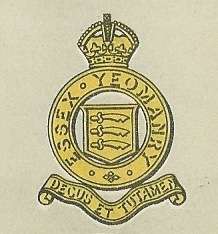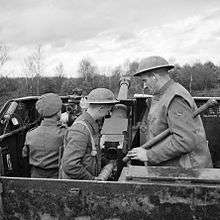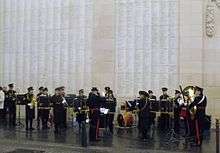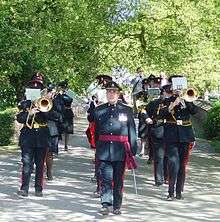Essex Yeomanry
| Essex Yeomanry | |
|---|---|
 Essex Yeomanry cap badge (1940s) | |
| Active |
1797–1828 10 February 1831 – 31 March 1877 13 February 1902–present |
| Country |
|
| Branch |
|
| Type | Yeomanry |
| Role | Signals |
| Size | Squadron |
| Garrison/HQ | Colchester |
| Motto(s) |
Decus et Tutamen (Shield and Protection) – 1831–77; 1909 onwards Audacter et Sincere (Gallant and Loyal) – 1901–09 |
| Engagements |
|
| Commanders | |
| Notable commanders |
Richard Beale Colvin[1] Reginald Hobbs |
The Essex Yeomanry is a British army unit which originated as a yeomanry regiment raised in 1797. It saw service in the Second Boer War, the First World War and the Second World War. Its lineage is maintained by 36 (Essex Yeomanry) Signal Squadron, part of 71 (Yeomanry) Signal Regiment, Royal Corps of Signals.
History
Formation and early history
In 1793, the prime minister, William Pitt the Younger, proposed that the English Counties form a force of Volunteer Yeoman Cavalry that could be called on by the king to defend the country against invasion or by the Lord Lieutenant to subdue any civil disorder within the country.[2] The unit was raised in 1797 as a number of independent troops. The regiment was brought together as the Essex Yeomanry Cavalry in 1814 but was disbanded in 1828.[3] On 10 February 1831, the West Essex Corps of Yeomanry Cavalry (of one troop) was formed. It continued to serve without pay from 1838 to 1843. On 23 July 1852, it was designated as the West Essex Regiment of Yeomanry Cavalry. It was disbanded on 31 March 1877, but a troop continued to serve with the Loyal Suffolk Hussars.[3]
Second Boer War
In 1902, the Essex Imperial Yeomanry was raised with four sabre squadrons, one machine gun section, and its regimental headquarters at Colchester Garrison. In 1908, the regiment was renamed the Essex Yeomanry and transferred to the Territorial Force.[3]
- Regimental Headquarters was at Colchester
- A Squadron was based at Colchester
- B Squadron was based at Braintree
- C Squadron was based at Waltham Abbey
- D Squadron was based at Southend
First World War
| Eastern Mounted Brigade |
|---|
|
Organisation on 4 August 1914 |
|
Assigned units
|
|
Training attachments
|
|
In accordance with the Territorial and Reserve Forces Act 1907 (7 Edw. 7, c.9), which brought the Territorial Force into being, the TF was intended to be a home defence force for service during wartime and members could not be compelled to serve outside the country. However, on the outbreak of war on 4 August 1914, many members volunteered for Imperial Service. Therefore, TF units were split in August and September 1914 into 1st Line (liable for overseas service) and 2nd Line (home service for those unable or unwilling to serve overseas) units. Later, a 3rd Line was formed to act as a reserve, providing trained replacements for the 1st and 2nd Line regiments.[4]
1/1st Essex Yeomanry
The 1st Line regiment was mobilized at Colchester on the outbreak of the First World War and, with the Eastern Mounted Brigade, joined the 1st Mounted Division in the Ipswich area. By the end of August 1914 it was in the Woodbridge area. At the end of November, it left the brigade and on 1 December landed at Havre.[5] The regiment joined the Royal Horse Guards and the 10th Royal Hussars in France on 12 December 1914 as part of 8th Cavalry Brigade, 3rd Cavalry Division near Hazebrouck. It remained on the Western Front for the rest of the war.[6][7] As such, it was one of only six yeomanry regiments to be posted to a regular cavalry division in the war.[lower-alpha 1]
The brigade and division saw action in the Second Battle of Ypres (Battle of Frezenberg Ridge, 11–13 May) and the Battle of Loos (26–28 September) in 1915. 1916 saw no notable actions, but in 1917 the division took part in the Battle of Arras (First Battle of the Scarpe, 9–12 April).[12] At other times, the brigade formed a dismounted unit and served in the trenches (as a regiment under the command of the brigadier).[13]
On 14 March 1918, the 1/1st Essex Yeomanry left the brigade to become a cyclist unit, then to form a machine gun battalion with the Bedfordshire Yeomanry. The German Spring Offensive forestalled this plan, and the regiment was remounted on 28 March and sent to the 1st Cavalry Division. From 4 April, it was split up with a squadron joining each regiment in 1st Cavalry Brigade (2nd Dragoon Guards, 5th Dragoon Guards and 11th Hussars).[5]
2/1st Essex Yeomanry
The 2nd Line regiment was formed at Colchester in 1914. In October, it moved to Wickham Market and by January 1915 it was in the 2/1st Eastern Mounted Brigade at Huntingdon. From June 1915 to March 1916, it was at Hounslow.[5] On 31 March 1916, the remaining Mounted Brigades were ordered to be numbered in a single sequence;[14] the brigade was numbered as 13th Mounted Brigade and joined 4th Mounted Division at Great Bentley.[5]
In July 1916, there was a major reorganization of 2nd Line yeomanry units in the United Kingdom. All but 12 regiments were converted to cyclists;[14] the 2/1st Essex Yeomanry remained mounted and transferred to the 3rd Mounted Brigade in the new 1st Mounted Division (3rd Mounted Division redesignated) at Leybourne Park, Kent. It moved to Brasted near Sevenoaks in March 1917.[5]
In September 1917, the 1st Mounted Division was converted to The Cyclist Division and the regiment became a cyclist unit in 13th Cyclist Brigade of the division at Sevenoaks. In December 1917, the 13th Cyclist Brigade was broken up and the regiment was posted to the 6th Cyclist Brigade in Ireland in January 1918. It remained with the 6th Cyclist Brigade until the end of the war, stationed at The Curragh.[5]
3/1st Essex Yeomanry
The 3rd Line regiment was formed in 1915 and in the summer it was affiliated to a Reserve Cavalry Regiment in Eastern Command. In April 1916 it was affiliated to the 2nd Reserve Cavalry Regiment at Aldershot. Early in 1917 it was absorbed into the 4th Reserve Cavalry Regiment, also at Aldershot.[5]
Between the wars
The regiment was reconstituted in 1920 as part of the Territorial Army with regimental headquarters at Colchester. In 1921, the regiment was converted from cavalry to artillery and became the 104th (Essex Yeomanry) Brigade, Royal Field Artillery.[3]
- Regimental Headquarters was at Colchester
- 413 (Essex Yeomanry) Battery was based at Colchester
- 414 (Essex Yeomanry) Battery was based at Harlow
In 1932, with regimental headquarters and 413 Battery transferred to Chelmsford, the regiment gained a 339 (Essex Royal Horse Artillery) Battery based at Colchester. In 1938, the regiment was renamed 104th (Essex Yeomanry) Regiment, Royal Horse Artillery (RHA).[3]
Second World War
At the outbreak of the Second World War in 1939, the "104th (Essex Yeomanry) Regiment, RHA" formed a duplicate regiment as part of the increase in British military manpower. The second Essex Yeomanry regiment was designated 147 Regiment RHA (Essex Yeomanry),[3] and reclassified as a field regiment in 1941.[15][16] In 1942 both 147th (Essex Yeomanry) and 86th (East Anglian) (Herts Yeomanry) Field Regiments supplied cadres to help form 191st (Hertfordshire and Essex Yeomanry) Field Regiment, Royal Artillery.[17]
104th (Essex Yeomanry) Regiment, RHA
The first line regiment went to the Middle East in 1940 and served in most of the Western Desert battles, notably the Battle of El Alamein and the Siege of Tobruk. It went on to fight in the Italian Campaign and was stood-down in Austria in 1946.[18]
147th (Essex Yeomanry) Field Regiment, RA

The new regiment landed on the beaches of Normandy on D-Day, 1944. It was equipped with Sexton Self Propelled 25 Pounder guns and fought with the British 8th Armoured Brigade as a spearhead unit through France, Belgium, the Netherlands, and into Germany.[18]
14th Regiment, RHA
Another regiment, 14th RHA, was formed in India on 1 September 1942.[18] It commanded 414th (Essex Yeomanry) Battery from 104th RHA, 524th Battery (formerly independent) and the newly formed 525th Battery.[19] The Regimental Headquarters, 524th and 525th Batteries were disbanded on 27 April 1946 and 414th Battery was placed in suspended animation in Middle East Land Forces on the same date. 414th Battery was reconstituted in 304th (Essex Yeomanry) Field Regiment, Royal Artillery on 1 January 1947.[20]
Post-war
The regiment was re-raised on 1 June 1947 as 304th (Essex Yeomanry) Field Regiment RA with headquarters at Chelmsford and batteries at Colchester (P), Southend (Q), and Harlow (R). The Royal Horse Artillery designation was restored in February 1955.[3] Following the defence cuts of 1967, the unit was reduced to squadron status as 70 (Essex Yeomanry) Signal Squadron, part of 71 Yeomanry Signal Regiment, Royal Corps of Signals.[3] On 25 April 2009, 70 (Essex Yeomanry) Signal Squadron was awarded the freedom of Harlow.[21]
Following the reorganisation of the Royal Signals Reserves in 2009, 68 (Inns of Court & City Yeomanry) Signal Squadron merged with 70 (Essex Yeomanry) Signal Squadron to form 68 (Inns of Court & City and Essex Yeomanry) Signal Squadron.[22]
Under Strategic Defence and Security Review in 2014, 907 Signal Troop was subordinated to 36 Signal Squadron, which then became 36 (Essex Yeomanry) Signal Squadron, part of 71 (Yeomanry) Signal Regiment.[22][23]
Battle honours
The Essex Yeomanry was awarded the following battle honours:[3]
- First World War
Ypres 1915, St. Julien, Frezenberg, Loos, Arras 1917, Scarpe 1917, Somme 1918, Amiens, Albert 1918, Hindenburg Line, St. Quentin Canal, Beaurevoir, Cambrai 1918, Pursuit to Mons, France and Flanders 1914–18
- Second World War
The Royal Artillery was present in nearly all battles and would have earned most of the honours awarded to cavalry and infantry regiments. In 1833, William IV awarded the motto Ubique (meaning "everywhere") in place of all battle honours.[24]
Essex Yeomanry Band


The Essex Yeomanry Band is one of the oldest established Military bands in the East of England, being originally formed in 1809.[25] In 1830, the Commanding Officer of the West Essex Yeomanry was financially supporting the Band out of his own pocket. An 1846 engraving shows a black drummer mounted on a white horse, sporting a plumed turban. The other mounted bandsmen wore the Yeomanry uniform of the period.[25] In 1877, the West Essex Yeomanry was disbanded, but later reformed to become the Waltham Abbey Town Band. However, this newly formed band proudly continued to wear the Yeomanry uniform.[25] The Essex Yeomanry became gunners in 1921, but still retained the Band.[25] By 1937, the band was in the full dress uniform of the Regiment, complete with plumed brass helmets.[25] During the Second World War, the Essex Yeomanry Band was disbanded, but reformed in 1947.[25] This was a difficult time for the players, as all the uniforms had been destroyed with the bombing of Chelmsford in 1943. In 1952, official recognition of the band was given by the War Office, but like the Regiment, it was withdrawn in 1968.[25]
See also
Notes
- ↑ The other five were:
References
- ↑ "Sir Richard Beale Colvin". Essex Regiment & Essex Militia History. Retrieved 8 May 2015.
- ↑ "Worcestershire Yeomanry Cavalry (1794-1994)". Archived from the original on August 15, 2004.
- 1 2 3 4 5 6 7 8 9 "Essex Yeomanry at regiments.org by T.F.Mills". Archived from the original on 15 July 2007. Retrieved 2015-05-02.
- ↑ Rinaldi 2008, p. 35
- 1 2 3 4 5 6 7 James 1978, p. 18
- ↑ "A Short History". Archived from the original on 24 February 2006.
- ↑ Baker, Chris. "Essex Yeomanry". The Long, Long Trail. Retrieved 8 March 2013.
- ↑ Becke 1935, p. 4
- ↑ Becke 1935, p. 12
- 1 2 Becke 1935, p. 20
- ↑ Perry 1993, p. 14
- ↑ Becke 1935, p. 22
- ↑ Becke 1935, p. 19
- 1 2 James 1978, p. 36
- ↑ Farndale, Annex D.
- ↑ Foakes & McKenzie-Bell, p. 20.
- ↑ Foakes, p. 22.
- 1 2 3 "Military Units of Essex (4)". Essex Yeomanry association. Retrieved 17 November 2017.
- ↑ "14th Royal Horse Artillery". Desert Rats. Retrieved 17 November 2017.
- ↑ Frederick 1984, p. 451
- ↑ "Harlow Star 'Freedom of Entry to Essex Yeomanry'".
- 1 2 "History". The Inns of Court & City Yeomanry Association. Retrieved 17 November 2017.
- ↑ "36 (Essex Yeomanry) Signal Squadron Colchester and Chelmsford". Ministry of Defence. Retrieved 17 November 2017.
- ↑ "Royal Regiment of Artillery at regiments.org by T.F.Mills". Archived from the original on 15 July 2007. Retrieved 2007-07-15.
- 1 2 3 4 5 6 7 "History". Essex Yeomanry Band. Retrieved 17 November 2017.
Bibliography
- Becke, Major A.F. (1935). Order of Battle of Divisions Part 1. The Regular British Divisions. London: His Majesty's Stationery Office. ISBN 1-871167-09-4.
- Farndale, General Sir Martin (1996). History of the Royal Regiment of Artillery: The Years of Defeat: Europe and North Africa, 1939–1941. Brasseys. ISBN 1-85753-080-2.
- Foakes, Colonel S.P.; McKenzie-Bell, Major M. Essex Yeomanry: A Short History. Essex: Temperley Media/Essex Yeomanry Association. ISBN 978-0-9572333-0-0.
- Frederick, J.B.M. (1984). Lineage Book of British Land Forces 1660–1978. Wakefield, Yorkshire: Microform Academic Publishers. ISBN 1-85117-009-X.
- James, Brigadier E.A. (1978). British Regiments 1914–18. London: Samson Books Limited. ISBN 0-906304-03-2.
- Mileham, Patrick (1994). The Yeomanry Regiments; 200 Years of Tradition. Edinburgh: Canongate Academic. ISBN 1-898410-36-4.
- Perry, F.W. (1993). Order of Battle of Divisions Part 5B. Indian Army Divisions. Newport: Ray Westlake Military Books. ISBN 1-871167-23-X.
- Rinaldi, Richard A (2008). Order of Battle of the British Army 1914. Ravi Rikhye. ISBN 978-0-9776072-8-0.
External links
| Wikimedia Commons has media related to Essex Yeomanry. |
- Baker, Chris. "The Essex Yeomanry". The Long, Long Trail. Retrieved 6 April 2015.
- Essex Yeomanry at regiments.org by T.F.Mills at the Wayback Machine (archived 15 July 2007)
- "Essex Yeomanry Association". Retrieved 8 May 2015.
- "Essex Yeomanry Regimental Information". Essex Regiment & Essex Militia History. Retrieved 8 May 2015.
- "71st (City of London) Yeomanry Signal Regiment". MOD. Retrieved 8 May 2015.
- "36 (Essex Yeomanry) Signal Squadron Colchester and Chelmsford". MOD. Retrieved 8 May 2015.
- "68 (Inns of Court & City and Essex Yeomanry) Signal Squadron". MOD. Retrieved 8 May 2015.
- 907 (Essex Yeomanary) Signal Troop
- "British Army". MOD. Retrieved 8 May 2015.
- "Essex Yeomanry Band". Retrieved 8 May 2015.